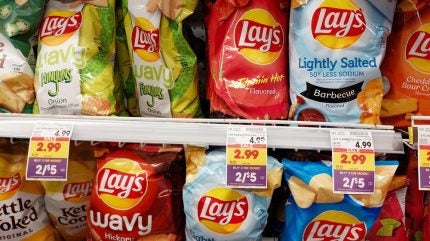
PepsiCo expects its business outside of North America to be a key driver of its revenue growth this year and for the longer term, while the company takes measures to fix weakness in Frito-Lay snacks.
While PepsiCo’s interpretation of the tariff impact and the subsequent downgrade in EPS guidance dominated headlines yesterday (24 April), the 2025 organic revenue growth outlook was left unchanged at a low, single-digit rate.
International sales encompassing both food and drinks outpaced the wider group in quarter one, growing 5% in organic terms versus 1.2% for PepsiCo as a whole.
While ex-North America revenue slowed from 9% in the same quarter of 2024, chairman and CEO Ramon Laguarta said yesterday: “We continue to see a long runway for profitable growth in our nearly $37 billion international business, which represented 40% of PepsiCo’s 2024 net revenue.”
Explaining the rationale to analysts, Laguarta said PepsiCo is investing in capacity for the “high growth” international business for food, snacks and beverages, as well as go-to market capabilities and individual brands.
“The momentum in international is one of the key underpinnings of the guidance that we reiterated on the top-line,” he added, although he pointed to pockets of weakness in some markets, including China, where he said the consumer is “hurting a little bit”.

US Tariffs are shifting - will you react or anticipate?
Don’t let policy changes catch you off guard. Stay proactive with real-time data and expert analysis.
By GlobalDataMexico is likely to be “impacted” by tariffs in the US, but Laguarta described India and Brazil as being in a “good place”, while PepsiCo is “seeing Europe navigating quite well”.
Frito-Lay “subdued”
Nevertheless, the US “will continue to grow at a very good rate” across food and beverages, he told analysts, adding: “When you think about the overall opportunity, both from the better execution to evolving the portfolio, to moving into new channels like away-from-home, we have tremendous opportunities to take our brands into new spaces and leverage the capability of our business.”
Frito-Lay in North America with savoury snacks, however, remained “subdued”, offset by “strong organic revenue growth” in convenient foods such as Quaker.
“Consumers have remained value‐conscious across brands and channels as the cumulative impacts of inflationary pressures have strained budgets and altered food shopping patterns,” Laguarta said with respect to Frito-Lay, which sits within the PepsiCo Foods North America (PFNA) division.
“Beyond affordability, bold flavour profiles, permissibility, functionality and portion control are key factors in defining value for consumers,” he added in terms of the fixes PepsiCo is taking to address the weakness.
As part of the Frito-Lay “portfolio transformation”, PepsiCo plans to provide consumers with more pack-size options at different price points.
At the same time, PepsiCo is “improving the operational excellence of Frito, both in terms of rightsizing the cost and improving the field rates and improving the granular execution in go-to-market”, Laguarta said.
EPS guide, food dyes
Frito-Lay was one of three factors cited by PepsiCo yesterday for its downgrade in the 2025 guidance for its core constant currency EPS.
The key factor for the outlook cut was the potential impact of tariffs and also “the heightened macro and consumer uncertainty”, as CFO James Caulfield said.
Core EPS is now expected to be “even” with last year’s 2024 print, compared to a previous forecast for a mid, single-digit rate of growth.
Also thrown into the equation was the impact from exchange rate fluctuations, a factor also cited by Nestlé yesterday in its own first-quarter results. However, unlike Nestlé pointing to strength in the Swiss franc amid general US dollar weakness linked to tariffs, PepsiCo’s earnings are denominated in the US currency.
PepsiCo noted yesterday that “substantial foreign-exchange headwinds” weighed on its reported revenue and core EPS by three and four percentage points, respectively, in the first quarter.
Based on current exchange rates, it expects a three-percentage-point impact on those metrics for the full year, and as a result, the new guidance for core EPS “implies” a 3% decline from last year’s $8.16.
“While our global business trends have remained resilient to date, we do expect the macroeconomic and consumer environment to feature elevated levels of volatility and uncertainty for the balance of 2025,” Laguarta said in his prepared remarks issued alongside yesterday’s results.
“The cumulative effects of inflationary pressures, coupled with the dynamic nature of global trade relations, will likely keep consumers choiceful and value conscious. Pockets of elevated geopolitical tensions are also expected to persist in certain international markets.”
Meanwhile, Laguarta was asked to comment on the US Food and Drug Administration’s plan (announced this week) to phase out the use of petroleum-based food dyes by the end of next year.
He said PepsiCo’s Frito-Lay and Tostitos snack brands will be free of artificial colourings by the end of this year.
“When we talk about the US and the food business, 60-plus percent of our business today doesn’t have any artificial colour, so we’re well undergoing that transition,” Laguarta told analysts.
“We’ll lead that transition and in the next couple of years, we’ll have migrated all the portfolio into natural colours or at least provide the consumer with natural colour options.”



